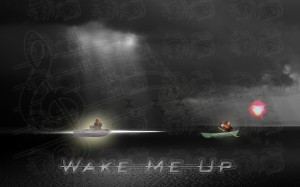Ready Writing Practice Essay #1
Patriotic Design
Silent Cry
Album Cover for “Wake Me Up”
Graphic Design Picture Collage
My picture collage has a red matrix background because red is my favorite color. I have many pictures stacked on top of this background to describe me and my hobbies. I also put pictures of my favorite items of interest, usually edited to hold a red or blue design, because blue is my second favorite color.
A Separate Piece #1 Summary
A Separate Piece is based upon two boys who become friends and then go through betrayal and many hardships. Both Gene and Phineas form a bond beginning with a jump into a river, and later the bond weakens with the fall from the very same tree, the fall of Phineas. Gene is responsible for this, becoming suspicious of his friend and trusting no one but himself. This non-trusting nature forces Gene to jostle the limb when is friend goes out into the tree. Gene visits Finny and attempts to resolve his guilt, but fails to do so and must leave back to Devon to continue his school year. Gene continues his year until Finny returns, where they once again form a bond and become the troublesome duo of Devon’s school grounds. These two friends continue their year with barely and bumps at all in their relationship, until another friend decides to hold court. This court looks over the accident at the tree, and turns Finny bitter against his best friend. As he attempts to leave he falls down the stairs and breaks his leg once again. Gene visits Phineas, and eventually they forgive and forget, only to result in the death of Phineas the next day. Gene finishes the year as an extension of Phineas, grateful for his many lessons on freedom and the value of life. He does not cry at his funeral, because you simply would not cry at your own.
A Separate Peace #9 Theme
Reflection
“In the deep, tacit way in which feeling becomes stronger than thought, I had always felt that the Devon School came into existence the day I entered it, it was vibrantly real while I was a student there, and then blinked out like a candle the day I left.”
This sentence reflects from Gene’s time as a man back to the childhood spent at Devon. His memory still has a tremendous hold on him, as evidenced by his ability to recall the events of fifteen years with such ease. He remembers the past with ease, and yet Gene admits that the school is valid only to him, existing simply within memory fifteen years later. The presence of memory, and its role over time, is a major theme of this book. When Gene ponders his thoughts on the past and on the lasting impact of the events he is describing, he only increases the importance of this theme within the novel.
 “I went back to the Devon School not long ago, and found it looking oddly newer than when I was a student there fifteen years before.”
“I went back to the Devon School not long ago, and found it looking oddly newer than when I was a student there fifteen years before.”
“I didn’t entirely like this glossy new surface, because it made the school look like a museum, and that’s exactly what it was to me, and what I did not want it to be.”
A Separate Peace #8 Freedom/Captivity
1. In the beginning of the novel Gene is in captivity to Devon and it’s thorough rules, determined to create a name for himself that excels past the background of all other teenagers and their history. His origination being a poor home is the south, he scrambles to screen his identity from spectators and create a cover of pure grandeur. Phineas is the exact opposite of Gene, determined to reject the system of Devon and be a nonconformist. He relies on his own freedom and self-ability to survive and create a name for himself, not the standards and merits of the boarding school he attends.
2. There is a situation in the book that both Phineas and Gene have different beliefs about, concerning actions and the initial intentions behind them. Sometime in the summer semester both of the boys ditch class and head to the beach. Gene is worried about his test the next day, fearing he will fail it without intensive study. Afterwards, when he does in fact fail the test, he begins to believe that Finny is sabotaging his studies so that he can be the best out of the two of them. Gene is captive to his suspicion and lack of trust, while Phineas is free of guilt and seeks only to entertain himself with daring activities. To Gene the beach trip is a front used to destroy his perfect record, while initially it is an attempt at personal freedom.
3. The development of the plot follows an interesting pattern concerning both freedom and captivity. In the beginning Gene is in captivity, chained to the rules and standards of Devon. However, Phineas begins to break the chains and teach Gene the true freedom of oneself. Whenever the first “accident” occurs, Gene simply falls captive once again, instead only to his own guilt. On his best friend’s return he begins to remove his bonds and free himself completely, but near the end of the novel Phineas becomes injured once again. Gene quickly overcomes his feeling of guilt only for his friend to die, and lives on with a silent defiance. The system will not control him, because he is an extension of Finny, who never could be controlled by the “fat men” of the nation.
4. The tree is a symbol, used as a branch to a new subject from page to page. One of these is the dual subject of freedom and captivity, which is mirrored perfectly from the defiant jump into the river to the excruciating fall to the ground. The tree becomes a symbol of hope, where Phineas can jump and remind himself that he doesn’t have to obey the school or become apart of the system and jump in his later years. However, the tree betrays him and sends him crashing to the ground, strapping permanent chains onto him for the rest of his inadequate life.
5. There are two rivers that simply cannot exist next to each other, being the complete opposite in every trait. The Devon is clean, pure and revitalizing to the touch, inviting a sense of superiority into any who enter it’s waters. It’s rival, the Naguamsett, is everything the Devon is not. “It [is] ugly, saline, fringed with marsh, mud, seaweed,” and dampens the spirits of all who glance at it. This is of course where Gene must have his first fight, being under the influence of rage pent up against himself and against his jailer: guilt.
A Separate Peace #10 General Review
In John Knowles’ complex and mesmerizing novel, A Separate Piece, the book is presented as a fascinating story of two young boys who attend the military boarding school of Devon, New Hampshire. Based back in World War II, the story focuses on the development and maturity of two boys who openly reject the war and create a mind set for other goals, such as the Olympics of 1944 and everyday freedom. However, as they excel through their senior year the threat looms ever closer and the two boys must deal with the problem once they graduate.
The novel presents an interesting view on the complexity of friendships, combining love, hate, war, and peace to create a chemical time bomb capable of wrecking the reader’s mind relating to how bonds originally function. The piece is a nice dose of twists and turns to keep the reader in silent anguish until moments of injury, insanity, and death interrupt the smooth flow of peace. Personally, there couldn’t be any changes that would create a novel that would twist the mind like this does. However, it would be interesting to view the story through Phineas’ eyes, and have Gene as the one who was injured. There is no doubt indeed though that John Knowles created the sensational novel for his readers, with every death and every betrayal a part of his grand plan.
A Separate Peace #7 Truths Concerning Human Nature
1. The human being as an individual reveres himself above all else, often forgetting the pain and misery many others suffer around him.
Phineas could be used for this text, but Brinker proves the far better individual to analyze. Before the second accident, Brinker pulls aside Gene to accuse him of “putting off enlisting” due to Finny. In his own blind path of glory he doesn’t care that Phineas could be hurt mentally from the “truth” he wishes to clear up. Brinker can’t have Gene because Phineas stole him away out of pity, and so the Yellow Peril determines to end this relationship once and for all by calling a court to serve his own needs.
2. The common individual who does not trust himself cannot trust others, which results in a paranoia that haunts the mind and causes it to find deception in every ally.
Gene is obviously the focus of this truth, being the main character who struggles with trust. Early in the novel he begins to develop a paranoia that leads to his betrayal of Finny. This paranoia begins when he thinks that his “best friend” is plotting against him, to excel beyond him and sabotage his attempts at valedictorian. Though not true, this thought propels Gene to do the unthinkable: intentionally harm his best friend.
3. When caught in the spotlight of weakness, everyone’s first instinct is to look for an exit where none can be found, and in desperate cases take extreme measures to escape the corner.
Gene exemplifies this trait early in the novel, and even recognizes that “sarcasm [is] the protest of people who are weak.” This is significant because he hides behind his mask of indifference, using sarcasm to form a wall so that no one can impede upon his true feelings or true life. Whenever he realizes that his wall is defective though, Gene panics and immediately brands Phineas as an enemy. This attempt to worm out of his position of weakness results in the injury of his best friend, Finny, who never did desire to condemn him.




